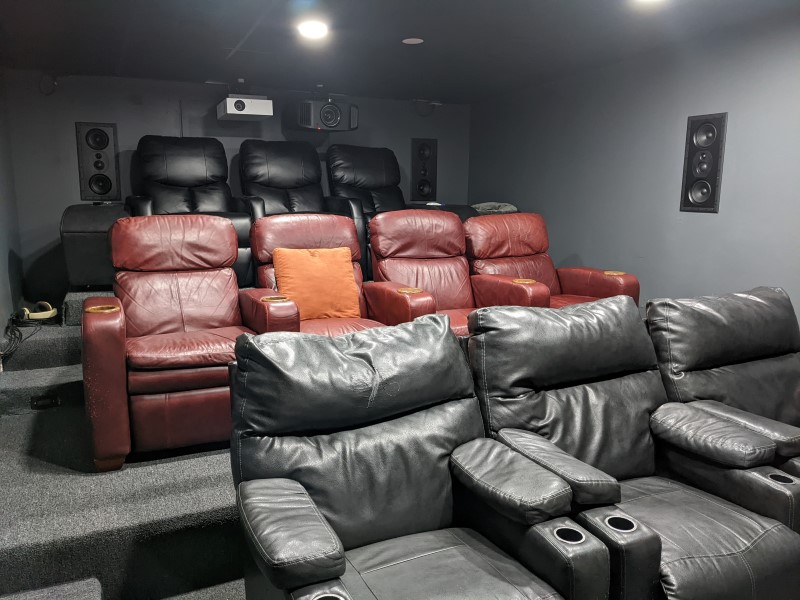Home Theater Rules of Thumb
You don’t have a home theater just yet, but you love to plan. You have lists of equipment that you keep updating as new stuff comes out. Weekends and free time are spent reading forums and blogs for advice and reviews. Heck, you’ve even started to dream about home theaters! But now you are starting to think about the room. Picking the gear is easy, all the rest of the stuff is hard. To help you out, we’ve put together our home theater “Rules of Thumb” which will help you plan your perfect room.
The Room
The vast majority of us don’t have much say in the size of the room we use for our home theaters. Whatever room is available is the one we use. Sometimes the room is smaller than we’d like, other times it is much larger. Either way, you can make it work. But if you are shopping for a house, what should you look for in a room to know that it will be good for a home theater?
First and foremost, if at all possible, you want a door. A room that can be closed off to the rest of the house makes everything much easier. Open floorplans are great for entertaining but they are horrible for bass and acoustics.

If you are looking at size, the rule of thumb is that you want enough width so that you can fit your couch (or home theater seating) along with an aisle on at least one side. Most couches are at least 10 feet wide but you are safer to assume 12 feet. The minimum aisle width should be three feet but you can get away with two in some circumstances. That means the very least the width of your room should be is 14 feet. Depth really depends on how many rows of seating and your preferred field of view. As long as you have at least 14 feet in one direction, you should be fine.
Speaker Distance
One of the most common questions we get is about amplifier power. If you don’t want to worry about how much power your AV receiver or amps have then make sure you don’t place your speakers too far away from your couch. Our rule of thumb when placing your home theater speakers is to keep all of them within 12 feet of your seat. This will ensure you can hit reference level without needing external amplification or speakers with high sensitivity.
TV Size
Yes, we’ve written a number of articles on how to pick the correct sized TV or screen. But if you are looking for a quick “Rule of Thumb” for screen size for your home theater, we’ve got you covered. Measure the distance (in inches) from your eyes to where you anticipate your screen to be in the room. Multiply that number by 0.75. That’s the diagonal measurement of the screen you should get (the size on the box). If that size seems wrong to you, check out our FOV article for a more complete explanation.

Couch Location
You’ve probably already learned that putting your couch against a wall can cause sonic issues. You may have also heard that you shouldn’t place it in the middle of the room. So…where then? Our rule of thumb for home theater seats is to place them a third of the way into the room from either the front or back wall. If you have two rows of seats, you could place the first row a third of the depth of the room from the front wall and the second a third from the back wall. If you only have one couch, then pick one of the two locations. Sonically, this should set you up for the best results.
Distance Between Rows
Speaking of two rows of seats, how far apart should they be? Of course, it depends somewhat on the design of the seats. As home theater seating often reclines, you can’t just look at the measurements in their upright position. If you are not sure what home theater seats you’ll end up buying, our rule of thumb is to have six feet from the back of one row (in an upright position) to the back of the second row (also in an upright position). This will give you enough room to recline both rows without bumping into each other. When both are upright, you should have plenty of room to walk between the two rows.

Riser Height
If you are going to have two rows of seats, you probably want to have the second row on a riser so that they can see the screen clearly. To step on the riser, you are going to want to have some steps. There are lots of rules about steps, but this is your home. If you want a non-code step height, you can build that. Just be ready for people to trip and/or complain. The general rule of thumb for steps is four to seven inches tall. We’d recommend six inches meaning you’d have a 12 to 18-inch riser (six wouldn’t be tall enough). The actual height would be predicated on your screen location. Remember to take into account people reclined when viewing.
Take Away
These “Rules of Thumb” won’t work for every home theater. That’s the nature of such rules. But if you keep them in mind when you are planning, you are unlikely to run into major issues. Do you have your own rules that you find helpful? Share them in comments!


